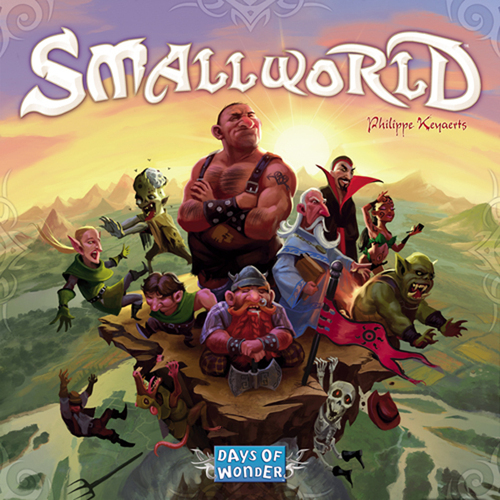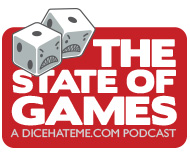Tom Gurganus Asks “What Makes a Game Great?”
Dice Hate Me and Go Forth and Game have joined forces to bring you some of the best gaming interviews on the web! That’s right, from time to time here on Dice Hate Me, Tom Gurganus will contribute one of his comprehensive conversations. In Part 1 of this special column, Tom shares one of his common questions that he likes to ask of each person interviewed. If you like this and would like to read Part 2, please check it out here on Go Forth and Game. Enjoy this special edition and be sure to let us know if there are other designers, artists or gaming insiders that you would like to know more about!
I’ve been doing interviews for Go Forth And Game for a couple of years now. One of the ideas I had with the interviews was spawned by a podcast, I don’t remember which one. They were talking about good players and good games. I thought that was these were interesting subjects and decided to add them as questions for my guests. With the idea of compiling their thoughts on the subjects and forming a discussion around these. This is the first of those discussions.
So what makes a great game? Let’s find out what everyone said first.
Cody and John of the late, lamented Game On podcast
John: A game that makes you think without making you OVERthink. In other words, a game that rewards optimal strategy, but doesn’t overly punish those who don’t play with optimal strategy. And, any game that you talk about weeks later is definitely a good one!
Cody: A game that produces great experiences and memories and keeps you coming back to the table.
The D6 Generation folks
 Russ: For me a game has to execute in all areas to be great: Rules presentation, Mechanics, Graphic Design, Component quality, and theme.
Russ: For me a game has to execute in all areas to be great: Rules presentation, Mechanics, Graphic Design, Component quality, and theme.
Rules: Should be easy and FUN to read. If you just dropped $60-$100 on a game, you want the rule book to look cool and get you and your friends excited.
Mechanics: Easy to learn, hard to master. Even ‘heavy’ games can be ‘easy to learn’ just look at the difference between a game like Rune Wars and a game like Android. Both by the same company, both do well in Rules presentation, Graphic Design components should be more than just bling. They should help you understand, follow, and execute game play.
Component Quality: Components should be good quality that will last under repeated play.
Theme: Theme should be carried through all of the above, even mechanics.
Example? Day’s of Wonder’s Small World is a great game. It nails all of the above flawlessly.
Nicole: A great game is playable by ANYONE. That means someone who is a hard-core gamer that looks for every angle to win and a person who is just in it for fun. If a game is too hard or complex, then a lot of people can’t or won’t play which makes it difficult to break out in a group. If a game is just way to simplistic, the same thing happens in the reverse. It needs to appeal and be playable to a wide audience in order for it to be great. It also needs to have clear, concise rules and a theme that is consistent throughout all elements of the game like board, cards, tokens etc..
Craig: What Russ calls Rules Transparency – the rules help move the game and theme along, not getting in the way of the fun. They have to be intuitive, but with a depth to present tactical choices and multiple avenues to victory. Elegant: simple, but deep.
Raef: Great graphic design, nice thick playing pieces, and replayability mixed with fun.
Doug & Shelley Garrett of Garrett’s Games and Geekiness
 Doug: I think we both would say that long games do not equal good games necessarily. I love a game that plays in under an hour, has solid, clear rules, and gets me thinking. China and/or Web of Power is my favorite game, and we can play a game of it in under 30 minutes; but the entire time I can feel the tension and love the planning of possible options as I wait for my next turn.
Doug: I think we both would say that long games do not equal good games necessarily. I love a game that plays in under an hour, has solid, clear rules, and gets me thinking. China and/or Web of Power is my favorite game, and we can play a game of it in under 30 minutes; but the entire time I can feel the tension and love the planning of possible options as I wait for my next turn.
Shelley: I agree with Doug’s sentiments here. A great game should have many paths towards victory, but be streamlined enough so that I don’t have to memorize too much. Simple icons and player aids can make a more complicated game feel more straightforward. I love a good think, but I don’t want to have to have a bionic memory of what others have and I don’t want to have to use a calculator to keep score.
Gavan Brown, graphic design artist extraordinaire and designer of JAB
This is a great question, and one that I’m sure everyone answers differently. In my opinion, a good game contains not one, but all of the following criteria: innovation, replayability (depth) and elegance. Theme and visual design, while I feel are important components to a game, I feel are secondary. But an ideal game is one that fires on all cylinders.
Sen-Foong Lim, one of the designers of Train of Thought and Belfort
To me, a good game should:
- Be easy to teach – As the person who usually buys the games in my local group, if the rules suck or the game is too confusing to teach, it’ll sadly never get played as I will invariably fall back on something I know more intimately when push comes to shove.
- Play in a reasonable amount of time – There’s not a lot of time in the day with 2 kids, a day job, game design, and being a competitive martial artists. I gave up RPGs because I couldn’t dedicate weekly 7 hour sessions to gaming. I also don’t think many of the gamers I play with could handle the same game for 3 hours.
- Have multiple paths to victory – Strategy games with one clear way to win are actually not very strategic…
- Have as many players involved at once, interacting as much as possible – The less downtime, the better. The less multi-player solitaire, the better.
- A theme that I can immerse myself in, if warranted – I like to play in game worlds I find interesting. I guess that comes from my RPG days. Theme can also be a limiting factor – My oldest son loves games, but I’m sure his mother wouldn’t want me playing “Mansions of Madness” with him…yet.
- Support a wide range of players (age, number, skill level) – My gaming partners range from 6 and 7 year old kids in a 2 player game to 7-8 players with grandparents involved. A game that can handle all that and in-between is a winner in my book. Scalability is a big plus.
- Have many meaningful decisions made throughout the game that impact on the end result vs. chance. If I lose a game because of a die roll, I am frustrated in a bad way. If I lose a game because of a poor decision on my part, I am frustrated in a good way.
- Lastly, the experience of playing a game should live on after the last card is drawn. If there is no post-mortem analysis of the game you just played – not necessarily out loud – then there may not have been enough strategic or tactical decisions, immersion/involvement/engagement, or player interaction.
If a game is good, you should want to play it again immediately with the thought that you could possibly do better – even if you won.
Colby Dauch of Plaid Hat Games (I also asked him, as a game publisher, what does he look for in a game.)
So these two questions belong together, because the things that I believe make a good game are going to be the things I look for in a game. First and foremost is fun factor. It’s not always easy to breakdown why a game is fun, but it has to have that fun factor when it is played before it is even worth breaking it down any further than that. A good game offers decisions to the players that are interesting and have multiple solutions with varying risk, reward and results. I do not like a game where the optimal moves are often clear or mathematical, which brings me to the next thing I like it a game – drama. I don’t like a game where it is decided by luck, but a game completely devoid of any chance lacks a certain sense of drama. I also like story in a game. That drama should help tell some sort of story. The players should have a chance to come together and imagine out the scenes that are taking place in the game. They should be able to tell stories afterwards with big hand gestures as they get excited about how things unfolded.
John Clowdus of Small Box Games
I tend to play a lot of card games. I generally like games with cards in them and some form of player interaction. It doesn’t have to be a knockdown drag out war kind of game, but I like to be able to affect other players, even if it’s just blocking a space on a board so they can’t get it. I generally don’t like games that last longer than an hour.
So that’s part one. In part two I’ll continue to review what my guests have said they feel makes a game a great game. And if we get finished with that we’ll talk about what was said.
Related posts:
- Origins Game Fair 2011: Day 3
- Origins Game Fair 2011: Day 2
- The Table Ahead – Dice Hate Me in Oct/Nov/Dec
- The State of Games, Episode 23 – The One About the Unpublished Masses
- The State of Games, Episode 25 – The One About Game Design

